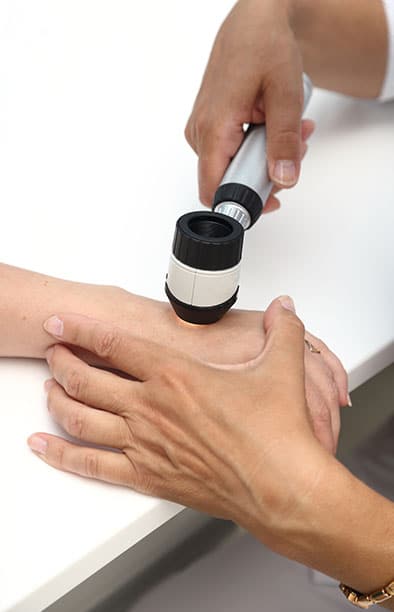What is Intense Pulsed Light Therapy?
Intense pulsed light therapy (IPL) is a non-invasive treatment option also known as a photofacial. The treatment is intended to improve the tone and texture of the skin without requiring surgery or other invasive options. IPL can be used to treat areas including the face, neck, chest, or hands.
Who is a Good Candidate for IPL?
IPL is a safe and suitable treatment for many patients. However, it may not be suitable for those who have tan or dark skin tones, as the treatment targets pigmentation and may damage the skin for these individuals. IPL is also not generally recommended for those who are pregnant or breastfeeding, have a history of skin cancer, are sensitive to light, use a retinoid cream, or have severe scarring or a history of keloids. During a consultation, your skin type and health history will be reviewed to ensure that IPL is a good option for you.
What Are the Benefits of IPL?
IPL can be beneficial for a wide range of tone and texture issues in the skin. For example, IPL can treat:
- Acne and acne scars
- Age spots
- Birth marks
- Discoloration and dark spots such as melasma
- Fine lines and wrinkles
- Freckles
- Rosacea
- Scarring
- Spider veins and other visible or damaged veins
- Stretch marks
- Unwanted hair
On Our Blog:
Fight Aging and Wrinkles with IPL
4 Reasons Why Winter is a Great Time for Laser Treatments
Light Therapy for Skin Care: What is IPL and What Does it Do?
How to Prevent Tone and Texture Issues
Preventing tone and texture issues begins with a consistent skincare routine and healthy lifestyle choices. Daily sun protection is crucial; using a broad spectrum SPF helps guard against sun damage, which can lead to age spots, freckles, and uneven skin tone.
Avoiding tanning beds, managing stress, staying hydrated, and eating a balanced diet also contribute to overall skin rejuvenation. For those prone to skin conditions like rosacea or hyperpigmentation, clinical treatments can help manage symptoms.
Before Your IPL Treatment
Before undergoing intense pulsed light treatment, patients should discontinue the use of retinoids, anti-inflammatory drugs, and herbal supplements that can increase photosensitivity or bruising. It’s also important to inform your provider of any recent laser treatments, chemical peels, or medications that may affect the healing process.
Individuals with darker skin tones or dark skin may be advised to explore other laser therapy options due to a higher risk of skin damage. On the day of your session, come with clean skin free of lotions, makeup, or sunscreen.
During Your IPL Treatment
IPL uses precise and intense light energy to target pigmented cells within the skin. This differs from laser treatments, as IPL emits multiple wavelengths of pulsating light. As the intense pulsed light source targets these cells, heat is generated. This damages the cells, triggering the body to remove them and stimulate new collagen to repair the skin. This results in more even skin tone with reduced redness or brown spots as well as improved texture with reduced wrinkles or fine lines.
Recovery After IPL Treatment
Immediately after an IPL treatment, you will likely feel some sensitivity similar to a sunburn. This typically lasts for 4-6 hours and can be calmed with an ice pack or cool compress. Some redness or bruising in the area may persist for a day or two after treatment. It is important to avoid direct sun exposure and apply SPF daily after IPL treatment. Most patients require multiple IPL sessions to achieve their goal results. Your appointments will be scheduled every 2-4 weeks.
Results from IPL treatment are usually noticeable beginning 2-4 weeks after treatment, and will gradually improve as the skin generates new collagen.
I’ve been a patient here for about 4 years, and I couldn’t be more pleased. The staff is really nice, and appointments are 90% on time, and the doctor is really great. He doesn’t over prescribe/offer unneeded treatments, and he is really just a nice guy. 10/10, 100% recommended.”
Read/Write Reviews
Combination Treatments for IPL
Intense pulsed light therapy (IPL) can be combined with a number of other aesthetic dermatology procedures to enhance results and provide more comprehensive skin rejuvenation, including:
Chemical Peel
When used alongside intense pulsed light therapy, a chemical peel helps to further exfoliate the skin, remove dead cells, and boost collagen production. While IPL therapy uses light energy to treat pigmented lesions, fine lines, and age spots, chemical peels work on the outermost layer to enhance overall skin texture and tone. These treatments are typically alternated over a few weeks to allow healing time and prevent irritation.
Botox
Botox and IPL treatment make a powerful duo in aesthetic dermatology. While IPL improves tone and texture, Botox relaxes the facial muscles responsible for expression lines. They work on different layers of the skin: IPL treats skin imperfections at the surface using pulsed light therapy, while Botox addresses dynamic wrinkles such as crow’s feet or frown lines.
Restylane® & Dermal Fillers
Restylane® is a popular dermal filler used to restore volume to areas of the face that have lost elasticity or firmness due to aging skin. When paired with intense pulsed light treatment, it can be used to address both volume loss and skin tone irregularities. However, it’s generally recommended to perform IPL therapy before filler injections to avoid disrupting the placement of the filler.
Schedule a Consultation
To learn more about IPL and find out whether it is a good option for you, schedule a consultation with Dr. Baird. Call (248) 213-8575 or contact us online.


